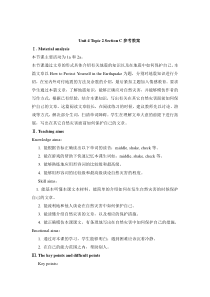 DOC
DOC
【文档说明】Unit 4 Topic 2《How can we protect ourselves from the earthquake》(SectionC)教案-八年级上册英语【仁爱版】.doc,共(6)页,31.000 KB,由小喜鸽上传
转载请保留链接:https://www.ichengzhen.cn/view-104272.html
以下为本文档部分文字说明:
Unit4Topic2SectionC参考教案Ⅰ.Materialanalysis本节课主要活动为1a和2a。本节课通过文章的形式具体介绍有关地震的知识以及在地震中如何保护自己。本篇文章以HowtoProtectYourselfintheEarthquake为题,
分别对地震知识进行介绍,在室内外对付地震的方法及余震的介绍,最后紧扣主题加入情感教育。要求学生通过本篇文章,了解地震知识,能够正确应对自然灾害,并能够模仿作者的写作方式,根据已有经验,结合本课知识,写出有关在其它自然
灾害面前如何保护自己的文章。这篇阅读文章较长,在阅读练习的时候,建议教师先以讨论、游戏等方式,解决部分生词,扫清单词障碍。学生在理解文章大意的前提下进行拓展,写出在其它自然灾害面前如何保护自己的文章。Ⅱ.TeachingaimsKnowledgeaims
:1.能根据音标正确读出以下单词的读音:middle,shake,check等。2.能在游戏的帮助下快速记忆本课生词如:middle,shake,check等。3.能够熟练地应用形容词的比较级和最高级。4.能够用形容词的比较级和最
高级谈论自然灾害的程度。Skillaims:1.能基本听懂本课文本材料,能简单的介绍如何在发生自然灾害的时候保护自己的文章。2.能流利地和他人谈论在自然灾害中如何保护自己。3.能读懂介绍自然灾害的文章,以及相应的保护措施。4.能正确模仿本课课文,有条理地写出在自然灾害中如何保护自己的
措施。Emotionalaims:1.通过对本课的学习,学生能够明白:遇到困难应该沉着冷静。2.在自己的能力范围之内,帮助别人。Ⅲ.ThekeypointsanddifficultpointsKeypoints:1.学习在地震中如何保护自己的知识。2.复习和巩固形容词的比较级和
最高级。3.能模仿本课所学文章,写一篇有关其它自然灾害的文章。Difficultpoints:模仿课文写一篇有关其它自然灾害的文章。Ⅳ.Learningstrategies1.通过对在地震中如何保护好自己的知识的学习,联想到其它的自然灾害以及处理方式。通过举
一反三的形式,可以让我们更加轻松地学习语言。2.在阅读文章的时候段落可以给我们带来很多提示。3.在复述文章的时候,将语言知识转化成像1b一样连贯图片可以帮助你更好地记忆文章。Ⅴ.TeachingaidsComputerm
ultimediaprojectorⅥ.TeachingproceduresStep1Introduction(6minutes)Studentactivity1.Studentstakeoutthehomework.Exchangetheirinf
ormationingroups.2.Onestudentspeakshis/herideaaboutapicture,otherstudentsshowtheirideasbysaying“Iagree./Idisagreewithhim/her.”3.Studentslookatthepi
ctures.Rememberthephrasesandconsiderwhethertheactivityisrightorwrong.4.Therearemanynewwordsforstudents.Buttheycanguessthemeaningofeachword.Forexampl
e,studentsdon’tknowthemeaningof“doorway”,buttheystudied“door”,andtheycanseeaboysittingonthefloor.Soth
eycanmatchthecorrectpicturesinthisway.Teacheractivity1.Askstudentstotakeouttheirhomework.Itissomeinformationabouthowtoprotectourselvesinanear
thquake.2.Playagame.Teachershowssomepicturestostudents.Studentscanseetheactivitiesofpeopleinthepictures.Stude
ntsstandupquicklyandspeakoutrightorwrong.Teachergivesthefirststudentasmilingface.3.EncouragestudentstodescribethepicturesinEnglish,forexample,
takealifttogodownstairs,runoutofaroom,andstandnearatalltree.Teachercanhelpstudentsiftheycannotexpressthepic
tures.4.TeacherchoosesmanyphrasesfromSectionCandshowsthemonthescreen.E.g.sitonthefloorinadoorway,stay
awayfromfurniture,stayawayfrompowerlines,andcheckthepeoplenearyou.Andshowmanypicturesonthescreen.Askstudentstomatch
thephraseswiththecorrectpictures.Step2Presentation(12minutes)Studentactivity1.Studentsreadthenewwordsaftertheteacher.Atthesametime,theytrytor
ememberthemeaningswiththehelpofthepictures.2.Studentsstudythestructureofthissentence.3.Studentsreadthroughthepassageandgetthemainideaofe
achparagraph.4.Studentsreadthroughthepassagejustnow.Trytofindtheparagraphwhichcangivetheanswers.Writedow
nthekeywordsundereachpicture.5.Studentsdiscussingroups.Putthepicturestogetherwiththeirownwords.Payattentiontothe
linkingwords.Finish1.Teacheractivity1.Afterstudentsknowthemeaningsofthenewwords,teachingthemthepronunciationbecomeseasi
er.2.Teacherasksstudents,“Doyouthinkknowingsomewaystoprotectyourselfwillhelptokeepyousafeinanearthquake?”Write“knowingsomewayst
oprotectyourselfwillhelptokeepyousafeinanearthquake”ontheblackboard.Explainthestructureofthissentence.3.Givestudents2minutestoreadthrought
hepassage.Remindstudentstogetthemainideaofeachparagraph.4.Showpicturesin1btostudents.Askstudentstowritedownthekeywordsundereachpi
cture.5.Givestudents2minutestodiscussingroups.Andinvitestudentstoreportwiththehelpofthepictures:howtoprotectourselvesinanearthquake.Step3Consolidat
ion(10minutes)Studentactivity1.Onestudentretellsthepassage,andhis/hergroupmemberscanhelphim/her.Otherstudentsremembertheways.Maybetheycanusethew
aysoneday.2.Studentsreadthepassageagainandfindouttheanswers.Inordertosavetime,theyneedn’treadsentence
bysentence.Readthequestionsfirst,thenfindouttheanswerswiththehelpofthekeyinformation.3.Studentssharetheiranswersandideasabouthowtofindan
swersquicklyandcorrectly.4.Studentsdiscussingroupsactively.Teacheractivity1.Invitestudentstoretellthepassage.2.Givestudents3
minutestoreadthepassageagainandshowthefollowingquestionsonthescreen:(1)Whencanearthquakesbeveryserious?(2)Howdoyouunderstand“thedangerisnotov
erwhenthestrongshakingstops”?(3)Whatdoestheword“aftershocks”mean?(4)Whatisthemostimportantthingtorememberinanearthquake?3.Invitestudentstoan
swerquestionsandaskstudentstosharetheirideasabouthowtofindtheanswersquickly.4.Showthefifthquestiontos
tudents,andencouragestudentstospeakoutmorewaystoprotectourselvesfromanearthquakeStep4.Practice(10minutes
)Studentactivity1.Studentsdiscussthefivepicturesingroups.Somestudentsmayusethephrasesin2adirectly.2.Studentsmatchthepictureswit
hthephrases.Anddiscussingroupswiththesephrases.3.Studentslookatthetablecarefullyanddiscussingroupswiththehelpof2a.Theycandiscussingroupswiththehe
lpoftheteacherlikethis:A:Themostimportantthingtodoistocall119forhelp.B:Thesafestplaceisthehighestfloor.C:Goingdownstairsis
saferthantakingthelift.4.Volunteersperformtheirconversations.Theyshouldcombine2awith2bintheirconversations.Finish2a,2bTeacher
activity1.Showthepicturesin2atostudents.EncouragestudentstodescribethepicturesinEnglish.2.Showthephrasesandthepicturesin2a.Askstudentst
omatchthephraseswiththecorrectpicturesandthendiscussingroupswhatyoushouldandshouldn’tdoinafire.3.Show2btostudents,andaskstud
entstomakedialoguesingroups.4.Invitestudentstoperformtheirconversations.Givesmilingfacestothevolunteers.Step5Production(6minutes)Studentactivit
y1.Studentsmayhavedifferentreactions.Moststudentsrunoutoftheclassroomliketheteacher,butsomestudentsstayontheseat.Theymaydon’tknowwhathappened.Only
afewofthemcangetthecorrectreaction,puttingtheirarmsontheheadtoprotecttheirheadandneck,thenstayingawayfromthewindows.2.Studentshandupactivelya
ndspeakouttheirownideas.Thenknowwhattheteacherdidiswrong.Theywon’tdoitlikethat.3.Studentsreadthenewwordsandreviewtheusageofcomparativea
ndsuperlativedegreesofadjectives.Theyknowhowtoprotectthemselvesinanearthquake.4.Reviewthenewwordsandreadingskills.Searchinformati
onontheInternet.PreviewSectionDandwriteapassage.Teacheractivity1.Playagame.Teachershouts“earthquake”loudlyandrunsou
toftheclassroomquickly.Thencomebacktoseethestudents.Thispracticeisveryimportantforstudentsbecausetheymayuseitoneday.2.Teacherinvitesstuden
tstotellallthestudentswhattheydidjustnow.Isitright?Istheteacherright?Educatestudentsthatweshouldcalmdownwhenwemeetproblems.3.Teachersummarizeswha
tthestudentslearnedtoday:(1)Words:calm,middle,shake,check...(2)Grammar:comparativeandsuperlativedegreesofadjectives4.Homework:Thehomewor
kincludesthreeparts:Askstudentsto(1)SearchtheInternettogetsomeinformationaboutWenchuanearthquake.(2)Writeashortpassagewi
ththetitle“HowtoProtectYourselfinaFire”.(3)ReviewSectionsA-CtoprepareforSectionD.TeachingReflectionThiskindoftopiccanattractstu
dents’attentionveryeasily.Fromthisclass,studentscanlearntheknowledgeofprotectingthemselvesindisasters.Infa
ct,studentsarelackoftheseknowledge.Teachercancreatemorerealsituationstotraintheirabilityofescapingfromdisasters.
 辽公网安备 21102102000191号
辽公网安备 21102102000191号
 营业执照
营业执照